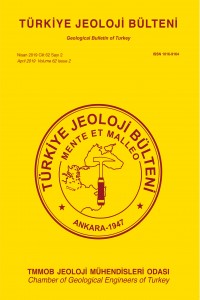Abstract
Büyük Menderes Nehri (BMN) 615 km uzunluğu ve
~24000 km2 lik akaçlama ile Ege Denizi'ne dökülen en büyük akarsu olup Batı
Anadolu'nun jeomorfolojisinin oluşumunda önemli rol oynamıştır. Nehrin aşağı
yatağı Büyük Menderes Grabeni (BMG), orta yatağı Denizli Grabeni, yukarı yatağı
ise Baklan-Dinar Grabeni içindedir. Bütün yatak boyunca, eğim kırıklıkları olan
yerler hariç, ana akış kanalı mendereslidir. Aşırı bükümlülüğü tanımlayan
'menderesli kanal (meandering channel)' terimi jeoloji literatürüne bu nehrin
tarihsel adı 'Maiandros Flu' esas alınarak üretilmiştir. Büyük Menderes
Deltası'ndaki (delta kompleksi) incelemelerin ortaya koyduğuna göre, BMN'nin
jeolojik geçmişi Geç Pleyistosen'de, son 250000 yıl içindedir. Bununla
birlikte, arazi ve sondaj bulguları, eski BMN'nin son Buzul Çağı sonlarına
kadar BMG içinde sınırlı kaldığını, bugünkü yukarı ve orta yatak bölümünde
akarsu yerine iki ayrı sığ ve geniş göl (Geç Pleyistosen Sarayköy Gölü ve
Baklan Gölü) bulunduğunu göstermektedir. Geç Pleyistosen'de Küfi ve Dinarsuyu
Baklan Gölü'ne dökülmektedir. Banaz Çayı ise Sarayköy gölüne ulaşmış ve bugünkü
Yeniköy kum ocakları ile temsil edilen büyük bir delta oluşturmuştur. Göller,
Holosen başında kapılmış (boşalmış) ve günümüzdeki nehri teşekkül etmiştir.
Yeni BMN'nin Baklan ve Sarayköy göllerini kapması, drenaj alanını ve taşınan
tortul miktarını artırmış, buna bağlı olarak son delta ilerlemesi çok hızlı
gerçekleşmiştir.
Supporting Institution
Ankara Üniversitesi; TÜBİTAK-YDAPÇAG
Project Number
106Y043
References
- Akdeniz, N., Konak, N., Öztürk, Z. ve Çakır, M.H., 1986. İzmir-Manisa dolaylarının jeolojisi. Maden Tetkik ve Arama Raporu, No 7929, Ankara (yayınlanmamış).
- Akgün, F. ve Akyol, E., 1999. Palynostratigraphy of the coal-bearing Neogene deposits in Büyük Menderes graben, western Anatolia. Geobios 32, 367-383.
- Akyol, İ.H., 1947. Türkiye'de "akarsu sistemleri" ve rejimleri. Türk Coğrafya Enst. Derg., 9-10, 1-36. Aksu, A. E., Piper, D.J.W. ve Konuk T., 1987. Quaternary growth patterns of Büyük Menderes and Küçük Menderes deltas, western Turkey. Sedimentary Geology 52, 227-250.
- Aksu, A.E., Konuk, T., Uluğ, A., Duman, M. ve Piper, D.J.W, 1990. Quaternary tectonic and sedimentary history of eastern Aegean Sea shelf area. Jeofizik 4, 3-35.
- Alçiçek, H., Varol, B. ve Özkul, M., 2007. Sedimentary facies, depositional environments and palaeogeographic evolution of the Denizli basin, SW Anatolia, Turkey. Sedimentary Geology 202, 596-637.
- Altunel, E., 1996. Pamukkale travertenlerinin morfolojik özellikleri, yaşları ve neotektonik önemleri. Maden Tetkik ve Arama Dergisi 118, 47-64.
- ...
Abstract
The River Büyük Menderes (RBM) with the 615 km
course and 24,000 km2 drainage area is the longest stream of not only
Anatolia but also whole eastern Mediterranean region, which discharges into the
Aegean Sea. It is also one of the driven elements on Quaternary morphology of
western Anatolia. Upper course of the RBM places in the Baklan-Dinar Graben
(BDG) while middle and lower courses are in Denizli Graben (DG) and Büyük
Menderes Graben (BMG) respectively. It has a meandering channel along the
longitudinal profile except for some short discontinuities. In fact, the
term“meandering” channel in earth sciences was originated from “Maiandros flu”
the antic name of the RMB. Based on results obtained from the BM delta (delta
complex), the life story of the BMR has been in the last 250,000 years
correspond to late Pleistocene. However, field geology and core studies
indicated that the old RBM was a short, limited stream at the BMG till last
Glacial Stage. During that time middle and upper course were separate drainage
basins containing two lakes called Sarayköy Lake and Baklan Lake respectively.
The Kufi stream and the Dinar stream have been discharging into the Baklan lake
during the Late Pleistocene, while the Banaz into the Sarayköy Lake producing a
delta represented by the modern open-sand pits of Yeniköy. Lakes have been
emptied by capture or back erosion and then large RBM could form in early
Holocene. This capture increased significantly drainage area, water and
sediment capacity of the new river, subsequently the uppermost part of the RBM delta complex occurred rapidly
Project Number
106Y043
References
- Akdeniz, N., Konak, N., Öztürk, Z. ve Çakır, M.H., 1986. İzmir-Manisa dolaylarının jeolojisi. Maden Tetkik ve Arama Raporu, No 7929, Ankara (yayınlanmamış).
- Akgün, F. ve Akyol, E., 1999. Palynostratigraphy of the coal-bearing Neogene deposits in Büyük Menderes graben, western Anatolia. Geobios 32, 367-383.
- Akyol, İ.H., 1947. Türkiye'de "akarsu sistemleri" ve rejimleri. Türk Coğrafya Enst. Derg., 9-10, 1-36. Aksu, A. E., Piper, D.J.W. ve Konuk T., 1987. Quaternary growth patterns of Büyük Menderes and Küçük Menderes deltas, western Turkey. Sedimentary Geology 52, 227-250.
- Aksu, A.E., Konuk, T., Uluğ, A., Duman, M. ve Piper, D.J.W, 1990. Quaternary tectonic and sedimentary history of eastern Aegean Sea shelf area. Jeofizik 4, 3-35.
- Alçiçek, H., Varol, B. ve Özkul, M., 2007. Sedimentary facies, depositional environments and palaeogeographic evolution of the Denizli basin, SW Anatolia, Turkey. Sedimentary Geology 202, 596-637.
- Altunel, E., 1996. Pamukkale travertenlerinin morfolojik özellikleri, yaşları ve neotektonik önemleri. Maden Tetkik ve Arama Dergisi 118, 47-64.
- ...
Details
| Primary Language | Turkish |
|---|---|
| Subjects | Geological Sciences and Engineering (Other), Physical Geography and Environmental Geology |
| Journal Section | Makaleler - Articles |
| Authors | |
| Project Number | 106Y043 |
| Publication Date | December 1, 2011 |
| Submission Date | August 3, 2011 |
| Acceptance Date | October 12, 2011 |
| Published in Issue | Year 2011 Volume: 54 Issue: 12 |
Cite
Instructions for Authors: http://www.jmo.org.tr/yayinlar/tjb_yazim_kurallari.php
Ethical Statement and Copyrighy Form: https://www.jmo.org.tr/yayinlar/tjb_telif_etik_formlar.php


